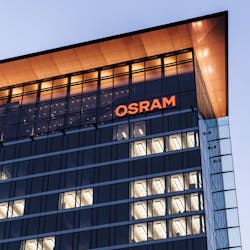Osram today reported that it eked out a €1 million ($1.1M) after-tax profit for its first quarter of fiscal year 2020 as nominal revenue edged up 5.5%, although it cautioned that growth for the year will be minimal at best, and said that legalities are hampering its efforts to establish business synergies with new owner ams.
In a conference call with analysts, CEO Olaf Berlien and chief financial officer Ingo Bank also answered several questions about coronavirus by noting that the potential impact is unclear and could be disruptive.
For the quarter ending Dec. 31, revenue grew to €873M ($958.6M) from €828M ($909.2M) in the same quarter a year earlier, when the company lost €5M ($5.5M) after taxes compared to this year's €1M profit. The 5.5% growth dampened down to 0.5% growth on a “comparable revenue” basis. Osram heralded the result as “a robust start to fiscal year 2020” given general economic and industry conditions. Adjusted EBITDA jumped 22% to €114M ($125.2M) from €93M ($102.1M).
Much of the improvement in earnings came from the Osram Opto Semiconductors unit, befitting a company that is emphasizing its chip-level photonics offerings over other business areas, such as digital, Internet-connected lighting. The photonics emphasis these days coincides with the acquisition of Osram by Austrian sensor firm ams, pending regulatory approval, expected in the calendar year's second quarter.
Osram attributed the income improvement to its ongoing “performance program” of cost cutting, to higher production volumes, and to changes in the IFRS 16 accounting standard. It said its EBITDA margin improved by nearly two percentage points to 13%.
"The performance programs initiated at an early stage had a lasting effect in the first quarter," CEO Berlien said. CFO Bank said the measures delivered €31M ($34M) of savings in the quarter, and are expected to total €80M ($87.8M) in savings for the full year 2020.
Cuts have included job reductions to 23,000 at the end of the quarter compared to 26,000 a year earlier. Bank said Osram is currently discussing additional actions with Osram labor representatives. “We are aiming to finalize these discussions towards the end of the second quarter,” he noted on the analysts' call. The quarter ends on Mar. 31.
Job losses have hit multiple Osram locations, including its newest chip manufacturing plant in Kulim, Malaysia.
While Premstaetten, Austria-based ams expects its acquisition to generate €300M ($329.5M) in operating synergies, Berlien said that discussions between the two companies on how to accomplish the savings cannot yet proceed in great detail. That's because ams needs to own 75% of Osram shares to hold those conversations without violating competition laws, unless Osram were to make the same confidential information available to other shareholders.
In its bid to acquire Munich-based Osram, ams tallied 59.9% ownership. That sub-75% level has also prevented ams from gaining control of Osram's cash flow, ironically setting off a scramble by ams to raise money through a rights issue to help finance the acquisition.
Ownership of 75% would under German corporate law establish a “domination agreement” that would allow ams and Osram to discuss plans without sharing information with non-ams Osram shareholders.
“If we do not have a domination agreement, we are both independent companies, and anything that we do has to be in the view that all shareholders get the same intention, so there will be no advantage for one shareholder,” Berlien said in response to a question about the agreement.
Berlien and Bank also noted uncertainty regarding the potential impact of coronavirus on Osram's business, which has a heavy reliance on China, the country at the center of the outbreak. Osram's Wuxi, China LED plant is scheduled to reopen on Monday after a slightly extended shutdown following the Chinese New Year, in accordance with government mandates, Berlien said. But he also noted that it's unclear how many workers will actually return on that day.
Besides its running own operations, Osram is also reliant on the Chinese supply chain and on selling into the Chinese market.
“We have to see what it means,” Berlien noted, sounding a similar note to his CEO counterpart at rival Signify, Eric Rondolat. “If my customer cannot produce, we cannot deliver. lt's not a clear situation. We have to follow it day by day.”
Overall for the first quarter, Osram's strongest profits were in Opto, where it registered EBITDA of €88M ($96.6M), up 28.2% from the same quarter in 2019. Comparable revenue was slightly down by 0.7%, but CFO Bank noted that operational efficiencies and higher volumes more than offset price erosion and inflation. Overall revenue rose nominally to €359M ($394.2M) from €352M ($386.5M) a year earlier.
In its drive to emphasize photonics, Osram is pushing optical chips including LEDs and lasers into a variety of markets, some of which are new, or less proven than others. Bank said much of Opto's growth came from the horticultural and outdoor market. On the other hand, sensing and visualization — two areas for which Osram has high hopes — “had a slow start in the new fiscal year, posting a revenue decline,” he said. Industrial demand for laser applications was soft, he noted.
Another sector, Digital, reported a 2.2% growth in comparable sales but a €1M EBITA loss, which was an improvement over the €10M ($11M) loss from a year ago. Digital includes Internet of Things (IoT) and other connected lighting systems, an area that ams is considering hiving off. CFO Bank said that Digital is now driven mainly by two businesses — horticultural lighting operations Fluence Bioengineering based in Austin, TX, and by entertainment lighting.
Osram's automotive business, which sells headlamps, brake lights and other lighting systems to the car market, showed a 2.9% EBITDA decline to €47M ($51.6M) from €48M ($52.7M), as comparable sales nudged up 0.7%.
The company said it is sticking with its previous outlook for revenue in 2020 of somewhere between plus-to-minus 3% growth. It expects an adjusted EBITDA margin for the year of between 9% and 11%.
MARK HALPER is a contributing editor for LEDs Magazine, and an energy, technology, and business journalist ([email protected]).





